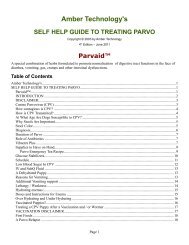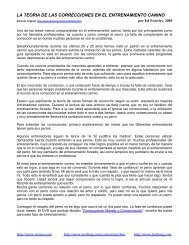Comparison of Stress and Learning Effects of Three Different ...
Comparison of Stress and Learning Effects of Three Different ...
Comparison of Stress and Learning Effects of Three Different ...
Create successful ePaper yourself
Turn your PDF publications into a flip-book with our unique Google optimized e-Paper software.
Opponents, on the other h<strong>and</strong>, argue that the use <strong>of</strong> electronic training collar is painful,<br />
unethical <strong>and</strong> unnecessary regardless <strong>of</strong> the severity <strong>of</strong> the training situation or problem<br />
behavior (OVERALL, 2007). In addition, British Small Animal Veterinary Association<br />
(BSAVA) (2003) claim that even highly motivated behaviors such as chasing prey can be<br />
elicited without using electronic training collars.<br />
There are some scientific researches examined effects <strong>of</strong> electronic training collars in the area<br />
<strong>of</strong> dog training. The studies conducted by SCHILDER <strong>and</strong> van der BORG (2003) <strong>and</strong><br />
SCHALKE et al., (2006) should be particularly mentioned. Both scientific researches<br />
conclude that using electronic training collars is only in accordance with animal protection<br />
principles if the following criteria are met: The user must have sufficient practical <strong>and</strong><br />
theoretical knowledge <strong>of</strong> these devices <strong>and</strong> must have undergone a test showing his capability<br />
to use them. Nevertheless, even if these criteria are met, the devices may only be used in<br />
specifically designated training situations.<br />
All in all, both scientific studies conclude that alternative training methods imply less stress<br />
on the animal, thus they comply with animal protection policies. Up to this day, however, no<br />
detailed scientific research has been conducted that could prove this hypothesis.<br />
The aim <strong>of</strong> this study is to investigate whether any stress is caused by the use <strong>of</strong> specific<br />
conditioned signal, quitting signal, <strong>and</strong>/or pinch collars as alternatives to electric training<br />
collars, <strong>and</strong> if they do so, whether the stress produced in the process is comparable to the one<br />
with electric training collars. Therefore, we set out to investigate the direct behavioral<br />
reactions <strong>of</strong> the dogs upon administration <strong>of</strong> above mentioned training methods. We are<br />
especially interested in finding out which method leads to less stress in dogs by comparing<br />
their behavioural effects.<br />
Furthermore, this study will examine the learning effects <strong>of</strong> the above mentioned training<br />
methods, i.e., electronic training collar, the pinch collar <strong>and</strong> the quitting signal. Thus, the<br />
compatibility <strong>of</strong> the learning effect <strong>of</strong> the quitting signal with the learning effect <strong>of</strong> the pinch-<br />
<strong>and</strong> the electronic training-collar, namely the compatibility <strong>of</strong> effectiveness <strong>of</strong> ‘’negative<br />
punishment’’ method with the ‘’positive punishment’’ method, in a training with high level <strong>of</strong><br />
arousal <strong>and</strong> motivation will be assessed.<br />
- 2 -














